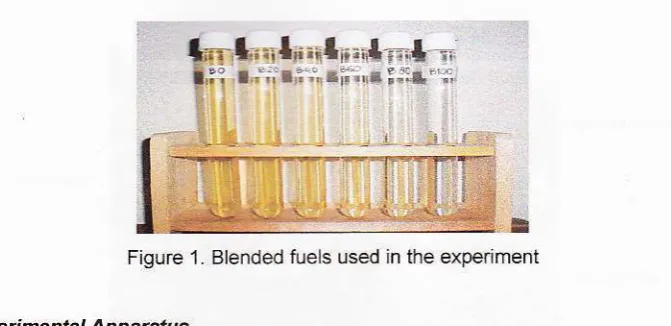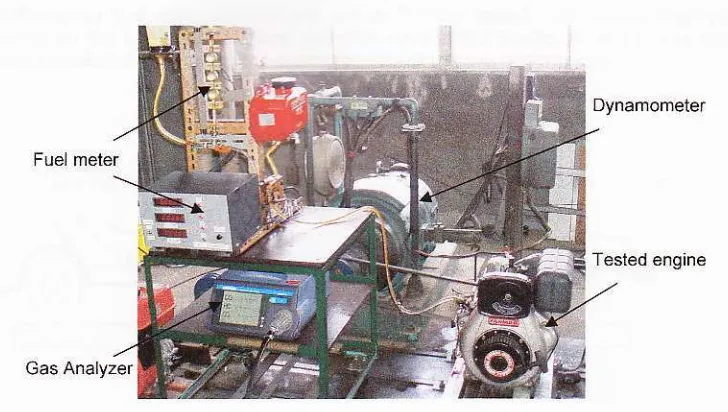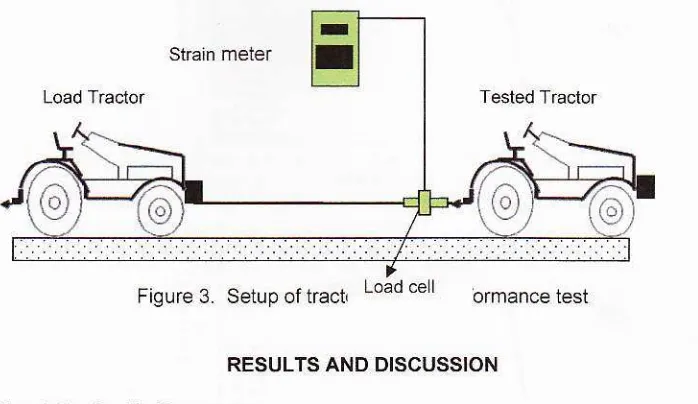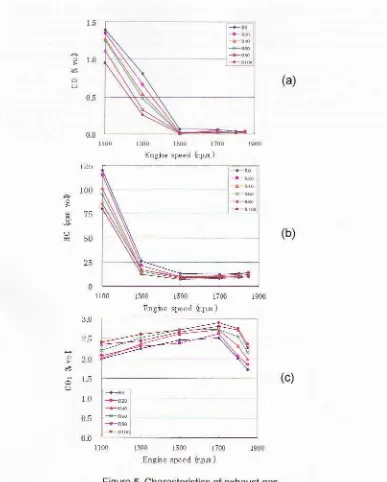Session A : Farm Machinery and l"lanallenent (FMM)
EVALUATION OF DIESEL ENGINE AND FARM TRACTOR PERFORMANCE POWERED BY COCODIESEL (CME)
Desrial
Departmentof Agricu tural Engineering, BogorAg cultural lJniversity PO Box 220 Bogor, Te p .lfax. \0251)8623026 e-mail: [email protected]
ABSTRACT
Playing its role as
a
develaping country, lndanesia alsa facing the energy crisis, therefote, Indonesian governnent strongly promotesthe
utilizattonof
alternative fuels As an agicultural cauntry, lndanesia incleed has
a
great potentialof praclucing vegetable oils such as palm oil, Jatrapha oil, cacanut ail, etc., which are
rcnewable mw mateialsfor biodiesel productian. The utilization of caconut oilas the raw matetialfor cocodiesel
is
very prospective, because Indonesia has 3.9 millionha af coconut tree, which is the largest in the world, and spreading along the coastal area. Applying
cocodi*el as
the altenative fuel for agicultural machinery and fishing vessel become very valuable, eapecially in the remote area where a huge amount of coconut oi! saurce is available while the price of petraleun dieselfuel js very high due to excesslve transpotTalian cost. This research is ained to evaluate lhe technical featutesof
the applicatian of cocodieselas
the alternative fuel farstatianary dieselengine as well as for agriculturcl ttactar. As the results afthis study,
it
was faund t'hatthe
diesel engine could run snaothly withal
blendlng rctiaof
cacadiesel fuel without notable problems. The engine peiormance charccteistics
of
statianary diese! engine by using cocodiesel blended fuels are closed to those af petroleum diesel fuels. Hawever, the naxjnum brake horse pawer value of engine
running on pure cocodiesel (81A0) is 10 670% lawer than that for petoleum diesel. It
was alsa rcvealed lhat glaba
y
rcgulated emission: CO and HC values of enginerunning on cocodie'el blended fuels are noticeably lower than that for petroleun diesel. Related rcsults were also obsetued
in
the applicationaf
cocodiesel for agriculturaltractor
The tractive peiormances of tractor using cacodieael showed sinilar behaviouta
those of petrcleum diesel, however,it
was revealed that thedrawbat power becomes lowet with the increaae af cacadiesel camposition in the
Kewods:
cocodiesel, engine peiormance, enission, ttactor dtuwbat pefornanceINTRODUCTION
Recently, there are many studies on alternative
fue
which are driven by theneed for new energy sources and the need to paotect the environment. Biodiesel is a desel repacement fuel that is manufactured from vegetable oils, recycled cooking
greases or o ls, or animal futs. The word biod esel in thls paper refers to the pure
fuel 8100 that meeis the specific biodiesel definition and standards approved by
ASTIVI jnternational. A numberfollowing the "B" ndicates the percentage ofbiodiesel in a ga lon of fuel where the remainder oi the gallon can be No. 1 or No. 2 dresel
lntematianal Synposium Agncultural Engineeting Towatds
Sutstanable Agiculture in Asia, Bogaa lndonesia, Novenber l &19, 2009
121
Sessian A: Farn Machinery and Managenenl (FMM)
fuel.
Nowadays,in
developed countrles blendingof
20% biodiesel with 80% diesel fuel (820) are cornmonly used in most applications that use diesel fue. Higherblend levels such as 850 or 8100, require special handling and
fue
managementand may require equipment modiic€tions such as the use of heaters or chang ng
seals and gaskets that come n contact with the iuel io those compatible wiih high blends of biodiesel The evel of special care needed Iargely depends on the engine and vehicle manufucturer.
Playing its role as a developing country lndonesia also fucing the energy crisis,
therefore, lndonesian government started
to
promote the use of a{ternative fuelslndonesla indeed has
a
lotof
plant derved oilslch
as palm oil and coconut oi.However, palm oil and coconut oil is categorized as edjble oil and its eonversion 1o biodiesel still debatable (Grimwood, '1975). Since the price of cooking oil made frcm
palm oil are cheaper than cooking oil made from coconut oil, so, the coconut based
cooking
oil are
lessprefefed in the
market. Therefore, recenUy, therea
hugenumber of oil resources frorn coconut are mighi be abandon. So, the aims of this
research is to investigaie the technical aspects of the potential of coconut oil as the
blodjesel
flel
for diesel engineOBJECTIVE
This research is aimed to evaluate the pedormance of diesel engine as well
as the properties of emission gas in applying coconut oil based biodiesel
fuel
The result of this research was cornpared to the peformance of diesel engine by lsingpetroleum based diesel fuel.
I'iIETHODOLOGY
This research was divided in to main two sieps. ln the first step, cocod ese
was applied to run a small diesel engine in order to evaluate the effect of cocodiesel
blended fuel to the engine performance and emisslon. The second step was the application
of
cocodieselfor an
agricultu€l hactorand
evaluatesits
drawbarpedormance as well. First step of this research was done at Faculty of Bioresources,
Mie
unjversity, Japan, whilethe
second stepwas
doneat
Bogor Agricultural University, lndonesiaMateial
The material will be used in this research is the cocod esel (Coco It ethyl Ester,
CNIE)
which
was
prccessedfrom
lndonesian commercial coconutoil.
Thiscocodiesel was made
by
meanof
transesterification wlth catalyst method usng potassium hydroxide and methanol.ln
addition Japanese commerca petroleumdiesel fuel (80) will also be used for the comparison purpose. The cocodiesel fueL was blended with petroJ diesel fuel at the level of 20%(B2A),40%(840) 60%(860),
80%(880)
and
100% cocodieselfuel
(8100).The
pictlre of
fuel
usedin
theexper ment is shown in Fiqurc 1.
lntemational Synposiun Agncultunl Engineenng Towards
Suistainabte Agdculture in Asia, Baltor, lndanesia, Novenber 18-19, 2009
Session A : Fam Machinery and Managenent (FMM)
l;-
L";
l;t
"lr',1;-,f
-,
i::
r.';tr
?",
si;.',s
F:iB"' 'i; [image:3.595.118.454.67.230.2]E
Figure 1. Blended fue s used in the expeimeni
Ex per i m enta I A p p a t at u
s
ln the first step of this research, a commercial four stroke, arr cooled diesel
engine was used for the experimental test. The engine capacity is 0.199 litre wlth max mum power output 3,'1 kW
/
1800rpm
The tested englne was connected to anelectric AC dynamometer (Toyo Denki seizo) and the engine torque was acquired
by
a
balance with constanl arm. The engine rotational speed was ireasured bydrgital tachometer (Shimpo DT-201).
The
fuei
consumptonwas
obtajned byvolumet c method where an automatic digital timer was used to measured elapse
time for a certain volume of fuel. The digital exhaust gas analyzer (Horiba IVIEXA-554JJ was
-sed'o
measurenent oflhe emission gasln the second step, a four wheel drive small tractor was used for evaluat ng
the tlactive pedormance of tractor powered by cocodiesel. The maximlm engine power of the tested tractor was 14 hp/2800
rpm
ln orderfo
provide oad to the tested tractor, a bigger size traclor was towed by the tested tractor while applying ltsengine brake The drawbar pullwas sensed by a load cell and recorded by a handy stra
n
meter. Other parametersie.
forwaad speed and wheel sllppage were also measured accodingly.Test Procedure
ln the first step of this research the Japanese comrnercial petrcleum diese
fr.rel (80) was used to power the diesel englne and the parameters of engine speed,
englne torque, fuels consumption and exhaust gas emission i.e.
CO
HC and CO, were measured at full ihrottle condition, correspondingly. Severalse
es of test weredone by uslng cocodiesel fuel blended with petrol diesel fuel at the level of 20%
(820), 40%(840), 60%(860), 80%(880) and 100% cocodiesel fuel (8'100). These raiio was made rn order
to
evaluate the effeciof
cocodiesel content in the fuel (l\rachacon etal,
2001). The ambient temperaiure and atmospheric pressure weremeasured at the beg nning and at the end of each test run for power correcton purpose (Hunt 1995). All test runs were staded with a 10 minutes warm-up perod prior to data collection The test were started at full throttle with maximum eng ne
speed (1850 rpm), then gradually dropped down
to
minimum possiby measuredengine speed (1100 rpm) by increasing the brake torque on the dynamometer. For
each speed readlng or daia acquisition were taken correspondingly The seiup of
engrne pedormance test is shown in Figure 2.
lntemational Synpasiun Agncultural Engineenng Towards
Suistainable Agncuture in Asia, Bagor, lntlanesia, November 18-19. 2009
E
Session A: Fann Machinery and Manasenent (FMM)
Dynamomeier
Tesled engine
[image:4.595.104.468.75.281.2]Gas Analyzer
Figure
2.
Setup ofengine performance testThe power delivered by the engine werc calculated by EqlaUon (1) (Goering, 1986):
r,
being:
PoC
... (1)
30000
: brake holse power (kuy'), : engine rotational speed (rpm), : torque (Nm).
The specific fuel consumption which is the ratio between fuel consumption and the power supplied at the same time by the engine is defines as Equation (2):
'=T
(2)being:
qs : speciflc fuel consumption (kg/kwh),: fuel consumption per hour (kg/h), : brake horse power (k\M.
The dlesel engine performance can be shown in term of relationship behveen engine torque, engine power and specific fuel consumption with engine speed (Ozkan et al., 2005). The characteristics ofemission can be expressed in term ofCOr, CO and HC content in exhaust gas ai d;fierent engjne load (Suryanarayanan et al., 2006).
ln the second step, the evaluation of the tractive performance of agricultural
tractor was ca.ri-Ad out on the standard concrete test road. The araangement of the
tEctive
performancetest is
shownin
Figure3.
The tested tractor was drjvenstraight ahead using L2 transmission
gear.
Load tractor was used for gradually increase the load applied to the tested tractor. The measured parameters on tractivelntenational Sympasiun Agncuftuml Ensineenns Towards
Suistainable Agicufture in Asia, Bogor, lndonesia, November 18.19, 2009
-Sessjon A: Fatrn Machinery and Management (FMM)
[image:5.595.102.451.119.321.2]performance test were drawbar pull,
actlal
fotuardspeed,
and wheel slppage Based on the above parameterc drawbar power, and coefflcient of traction ratio were calculated for showing the characteristics of taactive performanceFigure
3.
setupoftract,
Loadcel
brmance testRESULTS AND DISCUSSION
Diesel Engine Peio rma nce
The resu ts of diesel engine pedormance iest in term of relationship behveen engine torque, power and specific fuel consumption with engine speed are shown in
Figurc
4
(a), (b) and(c).
Figure 4(a) shows the variation of engine torque with the engine speed. The torque values for each tesi runs with differcnt blending raUo offuel show similar behaviour as the common engine torque performance
graphs
The maximum torque values reached at around 1300 rpm of engine speed for all fuels.However, the engine torque reduces gradually as the blendlng ratio of cocodiesel
increase. The maximum engine torque
by
using petrcleum diesel fuel (90) wasfound to be 19.4 Nm at 1300 rpm while for'100% cocodiesel fuel (8100) was 18.1
Nm
ai
1300 rpm. This result ndicated that the maximum engine torque by applying 100% cocodiesel (8100) is 6 57% lower than that wiih petroleum diesel (80).The variaiion of engine brake horce power for each fuel is shown in Figure
4(b). The maximum power reached at 1700 rpm of engine speed, and similar to the torque pedormance, the petroleum diesel fuel (80) has the grcatest power values.
The value of bEke horse power decrease as the raUo of cocodiesel fuels increase.
The maximum brake power by using peholeum dieselfuel {80) was found to be 3.13
kW at 1700 mm while for 100% cocodiesel fuel (8100) was 2.80 kW
at
1700 rpm. This result indicated thatthe
maximum engine brake powerby
applying 100o/ococodiesel (8100) is 10.67% lower than that with petroleum diesel (80). However, it
can
be seen frcmthe
power performance graphs thatthe
gapof
power loss becomes smaller when the load increased.lntemational Synposium Agncultaml Engineenng Tawards
Suistainable Agnculture in Asia, Bollat, lndonesia, Novenber 1 8-1 9. 2AAg
Session A : Fann Machinety and Managenent (FMM)
(a)
500
ri00Ensne speed Cpr )
1300
1500
r?00Dngne speed (tr.n )
(b)
€
;
ori19
o.r €'a
0.2(c)
Figure 4. Diesel engine pedormance graphs
The variation of specific fuel consumption (SFC) of these fuels are presented
in Figure 4(c). lt is rcvealed that as the consequences of the reduction of the brake power values, the SFC values of cocodiesel blended fuels are higher than that with
petroleum diesel fuel
(80).
The minimum SFC value with peiroleum diesel fuels(80) was 0.266 kg/kvvh at 1300
em,
and with cocodiesel fuel (8100) 0.301 kg/kwhat
1300 rpm. This result disclose that at the minimum curve of SFC, the SFC bylntemational Synposium Agncukuml Engineenng Towards
Suistainable Agdcultute in Asia, Bollir, Indonesia, Navenbet 18-19, 2009
[image:6.595.97.474.70.556.2]Session A : Farm Machinery and Managenent (FMM)
applying 100% cocodiesel (8100) is 13.46% higher than that witlt petroleum diesel
(80).
The characteristics of exhaust gas of diesel engine under load condition are
presented in Figure
5
(a),(b),(c). The variations of carbon monoxide, CO values inexhaust gas
ale
shownin
Figure 5(a). This figure exposes that the cocodieselblended fuels produce lower CO content, and the reduction
of
CO contents arcreduced remarkably when the load on the engine increase. The maximum reduction
of CO contents was found at the engine revolution 1300 rpm whlch is at maximum torque. The value of CO content was 0.81 % volume with petroleum diesel flrel {80) and 0.26 % volume with cocodiesel tuel (8100) This result make known that the CO
content on exhaust gas by applying 100% cocodiesel (8100) is
67I
% lower thanthat with petroleum diesel (80). This reduction might be done due to the increasing
the
orygen contentof the
cocodiesel fuel. I\rore complete oxidationof
the fuelresults in more complete combustion to cafuon dioxide aather than leading to the fomation of carbon monoxide.
The variations
of
hydrocarbon, HC values in exhaust gas are presented inFigure 5(b). Similar to the CO values, the cocodiesel blended fuels produce lower
HC content, compared to petroleum diesel. The reduction of HC contents tends to increase with
the
increaseof
the
load appliedon the
engine-The
maxirnum reduction of HC contents was found at the engine revolution 1100 rpm. The value of HC content was 120 % volume with petroleum diesel fuel (80) and 80 % volumewith cocodiesel fuel (8100)- This result disclose ihat the CO content on exhaust gas by applying 100% cocodiesel (8100) is 33.3 % lower than that with petroleum diesel
(80). Cocodiesel
is
comprisedof
vegetableoil
methyl esters,that is,
they arehydrocarbon chains of the
o
ginal vegetable oil that have been chemically splii off ftomthe
naturally occuning lri9lyce.ides". Cocodiesel hydrocarbon chains aregenerally 16
to
20 carbonsin
length, and they areall
orygenatedat
one end,making
the
productan
excellentfuel.
As
discussed above, several chemicalproperties
of
the
cocodiesel allowit to
burn cleanly and actually improve thecombustion of petroleum dieselin blends.
The variations of carbon dioxide, CO, values in exhaust gas are presented in
Figure 5(c)- ln contEry to the CO and HC values, the cocodiese{ blended fuels
prcduce slightly higher CO2 content, compared to petroleum diesel. At the maximum
brake power, the value of CO, was 2.52 % volume with petroleum diesel fuel (80) and 2.BS o/o volume with cocodiesel fuel (8100). This result reveals that the CO,
content on exhaust gas by applying 100% cocodiesel (8100) is 14.68 % higher than
that with petroleum diesel (80). As mentioned above that cocodiesel fuel improves
combustion process, therefore,
in
caseof
using cocodieseliuel or
cocodieselblended fuel, the Co2value in exhaust gas increased jnstead of
unburned HC and CO emission. Although the tailpipe carbon dioxide, CO, is higher for cocodiesel fuel ope€ted engines, cocodiesel fuel provides a distinct advantage
in a full lifecycle assessment in which emissions from fuel production and fuel use
are considered. ln the case of plant-based cocodiesel, carbon dioxide uptake by
plants during respi€tion offsets the CO2 emission.
Ii
is reported by USDE ihat bylifecycle analysis
the
total
reductionof
COzwas
78
yo \Nhen using soybeancocodiesel
Intemational
Swpxiun
Agncuftunl Engineenng TowatdsSuistainable Agriculture in Asia, Bagoa lndonesia, November 18-19, 2009
Sessian A: Farm Machinery and Managenent(FMM)
g
1.005
100
75
25
0
2.5
2_A
i.5
1.0
0,0
(a)
(b)
(c)
1300 1500
1700Efenc speed 0n.n )
l3d0
1500
1700 [image:8.595.86.473.73.555.2]lnsne speed (r.!r )
Figure
5
Chalacteristics of exhaust gasT ra clo
r
T ra ctive P e,'fom
a n c eThe results of hactive performance testwhich was done on
are shown in Figs.
6.
Based on the trend line exposed in thoseconcrete tesi rcad
graphs, lt can be
lntemational Synposium Agicuttural Engineedng Towatds
Suistainabte Agdcultute in Asia, Bogor, Indon$ia, Novenber 18'19, 20Og
Session A : Faffn Machinery and Managenent (FMM)
said that the characleristic of t€ctive performance curues for the tractor powered by
cocodiesel or blended cocodiesel shown almost similar tendencv with the tractiv; performance
c-rves
for the facror powereo oy petroleum d'ese; fuel. However. it was .evealed lhat rhe drawDar powef becomes .ower with the increase of cocodiesel composition in the fuel.Refered
to
Figures 6(a),the
drawbarpu
increase drasticay
with
the increment of wheel slippage untilit
reaches 25% to 30% wheet stip. The qraphsshown
that
the
drawbarpull
becomes lowerwith
the
increaseof
cocodieselcomposition
in
the
fuel. The
maximumd€wbar
pulls
of
tractor powered bypeholeum diesel on concrete was found to be 4.58 kN. However, when the tested
tractor was powercd by pure cocodiesel, the maximum drawbar pull decrcased up
lo 3 56 kN.
840
-860 -+830
2
35;3o
e ""
:
(a)
(b)
840 + 860 +BAa
[image:9.595.81.488.126.675.2]stip %
Figure
6.
Tractive performance graphs on concrete test roadlntemational Synposiun Agicuftuml Engineeing Towads
Suistainable Agdculture in Asia, Bogot, tndonesia, Novenber 1&19. 2AO9
129
Session A : Fann Machinery and Management (FMM)
The drawbar power tends
to
increaseas
the wheel slip increase uniil itreaches at
a
max,mum valueal
aboul 25o/o wheel slipas
shown in Figure 6(b).Then, drawbar power decreased with the increase of wheel
slip.
The reason whythis occurred is that the fonrard speed was decreasing while the drawbar pull was increasing slightly. The max'mum drawbar power of hactor powered by peiroleum
diesel on concrete was found to be 1.06 kW Similar with the trend ot drawbar pull,
the maximum drawbar power of tractor powered by pure cocodiesel decreased up
to 0.82
kW
lt means that the maxjmum drawbar power of tractor powered by puremmdiesel (8100)
is
about 23% lower than whenit
was poweredby
petroleumdiesel. The reason why the d€wbar power of tractor powercd by cocodiesel was
lower than that
by
petroleumdiesel
is
mainly dueto the
lower heat value ofcocodiesel. lt was reported by Hambali et al. (2007) that the heat value ofcocodiesel
and petroleum dieselare 32 [4Jlland 42 MJ/|, respectively.
CONCLUSIONS
ln
this
study, cocodiesel fuel (Coco Methyl Ester, CME) processed frommconut
oil
was testedas
altemative fuelfor
a
diesel engineas
weJlas
an agricultural tractor . lt was found that the diese' engine and tractor run smoothly withall
blendingratio
of
cocodieselfuel with
no
notable problems_The
engineperformance
and
tractive performances using cocodiesel blended fuels showed similar behaviour to those of petroleum diesel, however, it was revealed that thedieseJ engine
b€ke
horse power and the drawbar power of tEctor becomes lowerwith the increase of cocodiesel composition in the fuel. The maximum brake hoFe power value of engine running on cocodiesel fuel (8100) is 10.67% lower than that for petroleum diesel. Simibrry, the maximum drawbar power of tractor powered by
pu.e cocodiesel (8100) is about 23% lower than when it was powered by petroleum diesel (80).The globally regulated emission, CO and HC values of engine running on cocodiesel blended fuel are noticeably lower than that for petroleum diesel.
ACKNOWLEDGMENTS
The authoE
expresshis
gratitudeto
Prof.
Katsusuke Murakamj,proi
Nobutakalto,
Prof. Seizo Kato and Prof.Xiu
Lun Wangfor
providing him the facilities and support during the experiments. He also thanks the Japan StudentService Organization (JASSO) for providing him the financial support for conducting research in l\,,lie L,niversity, Japan.
REFERENCE
Goering, C.E.. 1986. Engine and Tractor Power. Boston, Pub USA. Grimwood, D.E.. 1975. Coconut Palm Product. Their Processing in
Developing Countries. FAO, U. Rome.
Hambali, E., S. lrujdalipah, Tambunan, A.H., Paftiwiri,
A.W,
Hendroko, R..2007.Teknologi Bioenergi. Agro l\redia Pustaka. Jakarta.
Hunt, D., 1995.
Fam
Power and lllachinery Management. 6th ed. towa State Univ. Press, Ames, lA.Intemational Synposium Agncultural Engineeing Towads
Suiskinable Agncufture in Asia, Bogor, lndonesia, Novenber 18-19, 20Og
Session A : Fam Machinery and Management (FMM)
N,lachacon, H.T.C., Matsumoto, Y., Okhawara,
C,
Shiga, S., Karasawa, T., and Nakamura, H., 2001. The Effect Of Coconut Oil And Dieset Fuel Btends OnDiesel Engine Performance And Exhaust Emission. JSAE Review 22, p.
349-355.
Ozkan, I\r., Ergen, C. and Deniz. 2005. Experimental perJormance Analysis of
Biodiesel, Traditional Diesel and Biodiesetwith Gricerine. Turkish J. Eng. Env. Sci. 29, p 89-94.
Senda, J., Okui, N., Tsukamoto, T., and Fujimoto, H.. 2004. On,Board
Measu.ement of Engine Performance and Emjssion in DieselVehicle
Operated with Biodiesel Fuet. SAE Technicat paper, 2004-01-003. Suryanarayanan, S., Manikandan, V., Sekar, J., Rao,
G
L. N., and Sampath, S..2006. Determination of the Proportion of Btend of Biodiesel with Diesel for
Optimal Engine Performance and Emission Charcteristics. SAE Technical Paper, 2006-01-3534.
htemational Synposium Agicultumt Engineeing Towards
Suiskinable Agicufturc in Asia, Bogoa tndonesia, Novenbet lB-19. 2OOg





